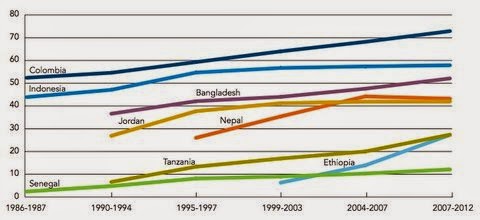Largely missed in much of this, as always seems the case with climate change discussions, is the role of population growth in contributing both to rising emissions of greenhouse gases and rising vulnerability to climate hazards in poor places with high fertility rates (think sub-Saharan Africa).
That’s too bad given that on Monday a separate special session of the General Assembly is scheduled to hold a 20th-anniversary review of actions since the International Conference on Population and Development in Cairo. As Bob Engelman of the Worldwatch Institute mused at a Wilson Center meeting in Washington last week, there needs to be much more crosstalk.
Obviously, rates of consumption of fossil energy and forests per person matter more than the rise in human numbers. As I’ve said before, 9 billion vegan monks would have a far different greenhouse-gas imprint than a similar number of people living high on the hog.
But family planning, for instance, should absolutely be seen as a climate resilience strategy in poor regions. This is how I put it in 2010:
Africa’s population is projected to double — from one to two billion — by 2050. That means exposure to [deep, implicit] climate hazards will greatly increase in many places even if climate patterns don’t change at all. So family planning, and sanitation and water management, sure sound like vital parts of any push for climate progress.On the Path Past 9 Billion, Little Crosstalk Between U.N. Sessions on Population and Global Warming

No comments:
Post a Comment